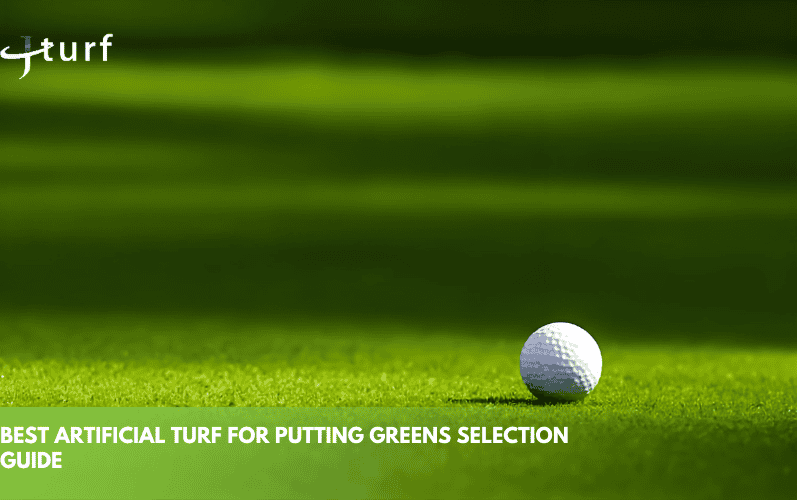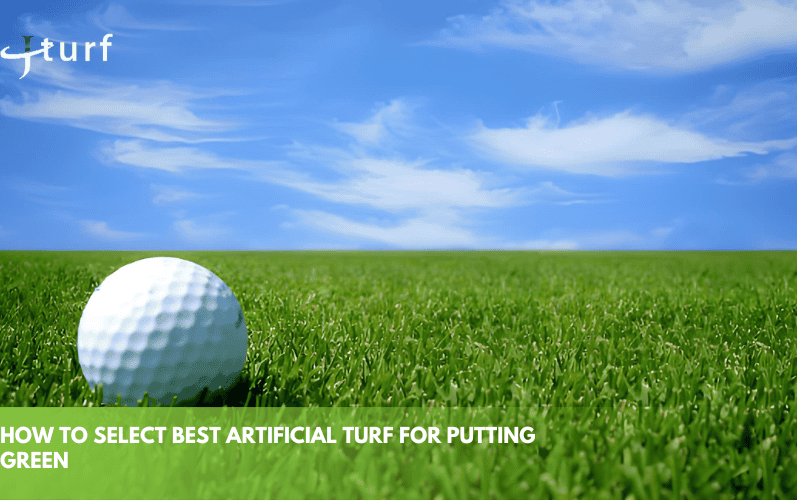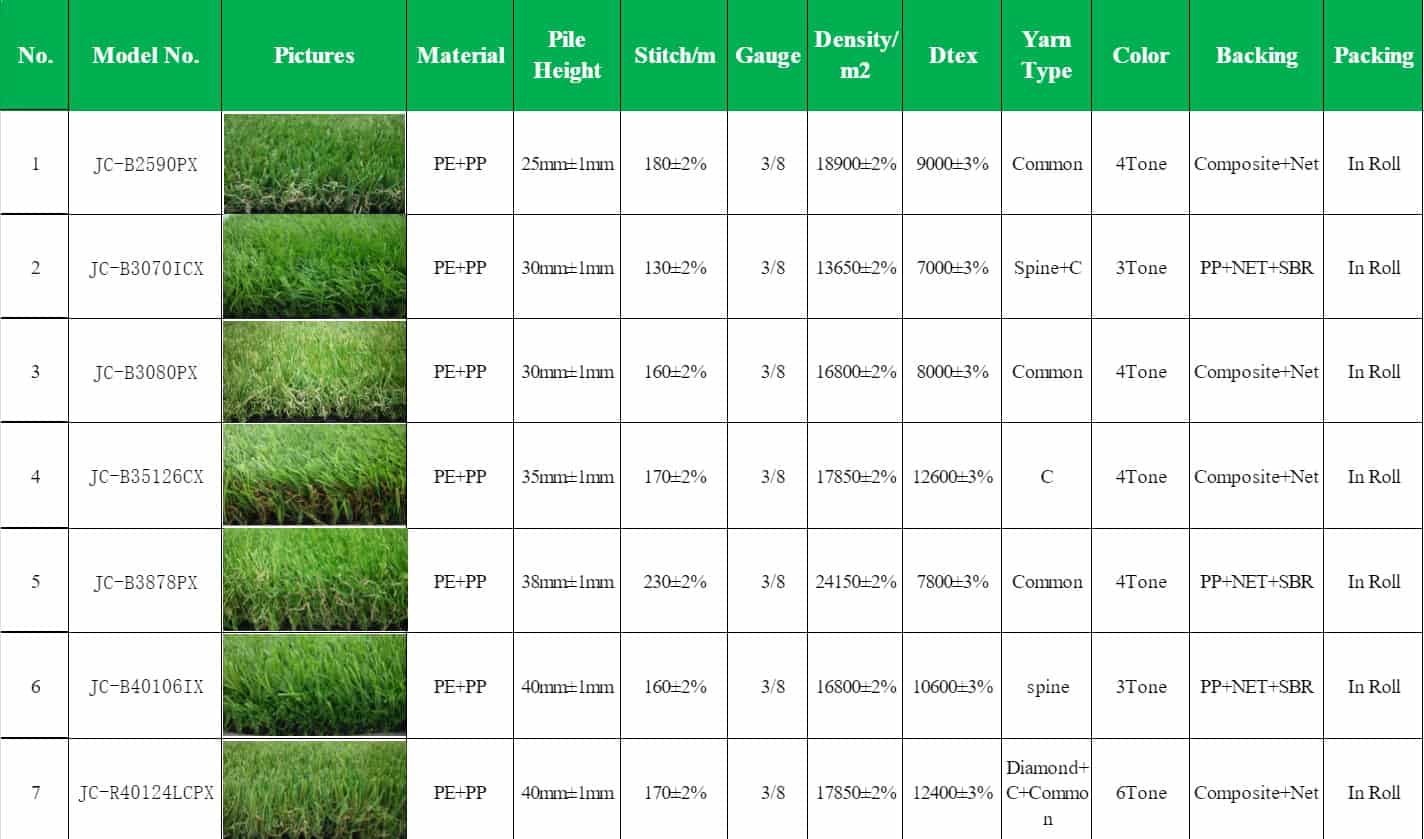Artificial turf offers the perfect balance of low maintenance, consistent ball roll, and long-lasting durability. In this guide, we’ll walk you through why artificial turf is the best option for your putting green, what makes the best turf, and how to select the perfect one based on your needs. We will additionally provide crucial installation and maintenance guidelines to make sure your putting green remains in excellent shape, offering you years of pleasurable practice.
Why Choose Artificial Turf for Your Putting Green?
Low Maintenance & Cost-Effectiveness: Eliminates the need for mowing, watering, fertilizing, and pest control, saving significant time, effort, and long-term costs. While the initial installation cost may be higher, reduced maintenance and water expenses make it a budget-friendly option over time.
Consistent & Customizable Playability: Provides a uniform surface for predictable ball rolls and speeds, crucial for improving putting accuracy and muscle memory. Additionally, it can be customized with different pile heights and undulations to simulate various green speeds and challenges, catering to individual preferences.
Durability & Year-Round Use: Built to withstand heavy foot traffic, weather damage, and wear and tear, ensuring long-lasting performance. Unlike natural grass, it remains usable year-round, regardless of weather conditions, offering consistent practice opportunities.
Water Conservation & Environmental Benefits: A sustainable, water-wise choice that is particularly beneficial in drought-prone areas or for environmentally conscious individuals.
Enhanced Aesthetics: Designed to mimic the look and feel of natural grass, it adds an appealing and polished aesthetic to any backyard or practice area.
Artificial Turf for Putting Green vs. Other Artificial Turf
| Feature | Putting Green Turf | Other Artificial Turf |
| Surface Texture & Pile Height | Low pile height (0.5-0.75 inches), dense and smooth for consistent ball roll. | Longer pile height (1.5-2.5 inches), softer, designed for cushioning or aesthetics. |
| Ball Roll & Playability | Engineered for precise ball roll and speed, customizable for different green speeds. | Prioritizes comfort and shock absorption, unsuitable for precise ball rolling. |
| Fiber Material | Nylon or polypropylene, durable and firm for golf-specific use. | Polyethylene, softer and more flexible for landscaping or recreational use. |
| Infill Requirements | Uses silica sand for firmness and consistent ball performance. | Rubber or sand-rubber mix for cushioning and stability. |
| Design & Customization | Customizable with undulations and slopes to mimic real golf greens. | Limited customization, mostly for color or pile height in landscaping. |
| Durability | High resistance to foot traffic and repetitive ball movements. | Durable for general use but not optimized for precision sports like golf. |
| Maintenance | Requires brushing and infill adjustment to maintain smoothness. | Minimal maintenance, focused on cleaning and keeping fibers upright. |
What Makes the Best Artificial Turf for Putting Greens?
When selecting the appropriate artificial turf for your putting green, it is essential to take various factors into account, including material, pile height, density, and infill options.
Material Matters – Nylon vs Polyethylene vs Polypropylene
Nylon: The most durable choice, nylon is ideal for professional-grade putting greens and high-traffic areas. It resists wear, maintains its shape, and provides a firm surface for consistent ball roll. However, it entails a greater expense and might have a slightly stiffer texture.
Polyethylene: Known for its soft, realistic feel, polyethylene is cost-effective and perfect for residential putting greens. It offers a good balance of durability and comfort but may require more maintenance in high-traffic settings.
Polypropylene: Budget-friendly and suitable for low-traffic areas, polypropylene is softer but less durable than nylon or polyethylene. It’s a great choice for casual golfers prioritizing affordability over longevity.
Key Comparison: Nylon excels in durability and performance, polyethylene offers the best value for homeowners, while polypropylene is ideal for occasional use on a budget.
Pile Height and Density – Getting the Right Feel
Pile height and density directly impact the putting green’s performance and longevity.
Optimal Pile Height: For putting greens, a pile height of ½” to ¾” (12–19 mm) is ideal. This low pile ensures a true, smooth ball roll, mimicking professional golf course greens. Taller piles (above ¾”) can slow the ball and disrupt consistency.
Density: Measured in ounces per square yard, a density of 40–60 oz is recommended for putting greens. Higher density enhances durability, prevents flattening, and ensures consistent play, especially in high-traffic areas.
Minimal Pile Direction: Prevents excessive lean that could affect ball roll speed and direction.
Pile Height and Ball Control: Shorter piles provide better ball control, as they reduce friction and allow for predictable roll. A denser turf also minimizes ball wobble, creating a more authentic putting experience.
Tip: For a tournament-grade feel, opt for a ½” pile height with a 50+ oz density. Recreational players can choose slightly taller piles (up to ¾”) for a softer surface.
Infill – Sand vs. Rubber vs. Other Options
Infill is critical for controlling ball speed, maintaining turf stability, and enhancing durability. Different infill types offer unique benefits:
- Sand Infill: Silica sand is the most common choice for putting greens. It provides a firm, stable surface, supports consistent ball speed (stimp ratings of 8–10), and is cost-effective. However, it could necessitate periodic refilling as a result of settling.
- Rubber Infill: Typically made from recycled tires, rubber infill is softer and can slow ball speed (stimp ratings of 6–8). It’s less common for putting greens but suitable for casual setups where a softer feel is preferred.
- Cork or Other Organic Infills: Cork is a sustainable, lightweight alternative that offers a natural feel and moderate ball speed. It’s eco-friendly but more expensive and less widely available.
How Infill Affects Performance:
- Ball Speed: Less infill (or finer sand) increases speed; heavier infill slows the roll.
- Consistency: Evenly distributed infill prevents uneven patches and ensures predictable putting.
- Durability: Sand and cork provide better UV resistance than rubber, extending turf life.
How to Choose: Select silica sand for professional-grade greens with fast, consistent roll. Use cork for eco-conscious setups or rubber for softer, slower recreational greens. Adjust infill quantity to achieve your desired stimp rating (e.g., 1–2 lbs per sq ft for sand).
Texturized vs. Slit Film
The yarn structure of artificial turf—texturized or slit film—affects its feel, performance, and maintenance.
Texturized Turf: With curled or crimped fibers, this turf provides a softer, cushioned surface. Ideal for recreational putting greens, it’s comfortable, aesthetically pleasing, and requires less infill, reducing maintenance. However, the ball roll is slower, with stimp ratings of 6–8, making it less suitable for professional-grade greens. Best for home setups focused on comfort and appearance.
Slit Film Turf: Made from flat, straight fibers, slit film provides a smoother, faster surface that mimics professional greens. It offers consistent ball roll with stimp ratings of 8–10, making it ideal for high-traffic or commercial greens. Although it demands a higher amount of infill and offers a firmer feel, its outstanding performance renders it the preferred option for dedicated golfers. It’s typically more expensive.

Customizable Playability
Top-tier turf offers customization options, such as varying pile heights, undulations, and green speeds. This allows golfers to replicate real-course challenges and tailor the surface to their skill level and practice needs.
Weather Resistance
- Weather Resistance: Designed for year-round use, premium turf withstands rain, UV exposure, and temperature fluctuations, ensuring consistent performance in any climate.
- Proper Backing and Drainage: A durable backing with excellent drainage prevents water accumulation and supports long-term use.
Cost Efficiency
- Low Maintenance Requirements: Minimal upkeep, such as occasional brushing and infill adjustments, allows golfers to focus on practice rather than maintenance.
- Long-Term Cost Efficiency: While the initial investment may be higher, reduced maintenance and water consumption make artificial turf a cost-effective solution over time.
Realistic Aesthetics
- Natural Look and Feel: High-quality turf mimics the appearance and texture of natural grass, creating an authentic putting experience.
- Textured Surfaces: Enhance ball roll and replicate the stimp meter reading of a real green, adding to the realistic feel.
How to Select the Best Artificial Turf for Your Putting Green
Selecting the right artificial turf for your putting green depends on your needs, whether it’s for a casual backyard setup or a professional-grade green. The key factors to consider are material, performance, and design features.
Recreational vs. Professional-Grade Turf
Your skill level and usage determine whether recreational or professional-grade turf is best.
Recreational Turf: Ideal for casual golfers, this turf uses texturized polyethylene or polypropylene for a soft feel and slower ball roll (stimp 6–8). It’s affordable ($2–$4 per sq ft), low-maintenance (2–4 lbs infill per sq ft), but less durable for heavy use.
Professional-Grade Turf: Suited for serious golfers or commercial greens, it uses durable nylon or slit-film polyethylene for faster rolls (stimp 8–10). Pricier ($4–$6 per sq ft) and requiring more infill (5–6 lbs per sq ft), it offers tournament-grade precision.
Indoor vs. Outdoor Putting Green Turf
When deciding between indoor and outdoor putting green turf, consider the following:
Indoor Turf: Ideal for controlled environments, offering consistent performance, low maintenance, and no need for weather resistance. Focus on smooth ball roll and aesthetics.
Outdoor Turf: Designed to withstand weather conditions like rain and UV exposure, with durable materials and proper drainage. Perfect for creating a realistic and long-lasting putting experience.
Turf Performance: What to Expect from Your Green
Turf performance hinges on ball roll, durability, and maintenance.
- Ball Roll (Stimp Rating): Recreational greens offer forgiving rolls (stimp 6–8), while professional greens provide faster, precise rolls (stimp 8–10). Slit-film turf with fine silica sand or Envirofill achieves higher stimp ratings.
- Durability: Professional turf (nylon) lasts 10–15 years under heavy use; recreational turf (polyethylene) lasts 7–10 years for light use. UV-resistant, antimicrobial backings extend lifespan.
- Maintenance: Recreational turf needs occasional brushing and infill top-ups; professional turf requires regular infill checks and grooming. Good drainage prevents water issues.
Recommended Artificial Turf for Putting Greens
JC-BY1650X: A slit-film polyethylene turf with a 16mm pile height and stimp rating of 9–10. Ideal for professional or home greens, it offers a smooth roll and durability. Best for serious golfers.
JC-ID1255P: A texturized polyethylene turf with a 9/16” pile and 36 oz face weight. With a stimp rating of 6–8 and low infill needs (2–3 lbs per sq ft), it’s perfect for recreational greens.
JC-ID1555P: A slit-film turf designed for indoor simulator greens, offering a stimp rating of 8–9 and high durability. It’s great for tech-savvy golfers or commercial setups.
Tips: You can ask us for samples to test the rolling and feeling before purchasing.
Customizing Your Putting Green Design
We provide personalized customization services for each customer to create your own putting green.
- Shape and Size: Small greens (100–200 sq ft) suit beginners; larger greens (500+ sq ft) allow complex layouts with multiple holes.
- Undulations: Use foam padding or base adjustments for slopes, adding realism and challenge, especially for professional greens.
- Fringe and Accessories: Add longer-pile fringe (1–1.5”) for chipping and accessories like cups or flags for authenticity.
- Indoor vs. Outdoor: Indoor greens need permeable backings; outdoor greens require drainage and UV-resistant turf.

Installation and Maintenance Tips for Your Artificial Putting Green
To ensure your artificial putting green performs well and remains durable, proper installation and maintenance are crucial. Here’s a concise guide to help you with both, whether you choose a DIY approach or hire professionals.
DIY vs. Professional Installation: Which Is Better for You?
Deciding between a DIY approach and professional installation hinges on your personal preferences, skill level, and the standard of quality you anticipate.
DIY Installation
Installing your green yourself is a cost-effective option. The process involves:
- Preparing the base: Clear and level the ground, then apply a compacted base (such as gravel or sand).
- Laying the turf: Unroll the artificial grass and secure it firmly, ensuring there are no creases or visible gaps between sections.
- Securing edges: Fasten the turf with staples or nails around the perimeter.
- Considerations: DIY can be rewarding but requires careful attention to detail. Uneven base preparation or misaligned seams can affect the performance of your green, especially the ball roll.
Why Professional Help?
If you’re aiming for a high-performance green, professional installation ensures durability and consistency, especially if you plan on using it frequently.
Easy Maintenance: Keeping Your Green in Top Shape
Maintaining an artificial putting green is simple, needing only minimal effort to keep it both visually appealing and in optimal playing condition.
Weekly Care
- Fluff fibers: Brush or use a power broom to lift the fibers, helping them retain their shape and promoting a consistent roll.
- Debris removal: Clear leaves and debris with a blower or broom, preventing buildup that could affect play.
Monthly Care
- Infill replenishment: Over time, infill settles or is displaced, affecting ball roll. Add more sand or rubber infill as needed to maintain the proper surface texture.
- Cleaning: Lightly hose down the turf to remove any dirt or grime.
High-Traffic Areas
- If certain areas are used more frequently, like around the holes, apply more infill to these spots and rotate hole placements to distribute wear evenly.
Common Installation Mistakes to Avoid
Even small errors during installation can affect your putting green’s performance. Here’s how to avoid the most common pitfalls:
- Misaligned Seams: Gaps or uneven seams can create inconsistencies in the ball roll. Ensure seams are properly aligned and securely fastened to avoid this issue.
- Poor Drainage: Inadequate drainage can lead to water pooling beneath the turf, resulting in damage and negatively impacting its performance. Ensure your base has a slight slope for effective water runoff.
- Insufficient Base Compaction: If the base isn’t compacted correctly, the turf may shift or become uneven. Make sure the base is stable and even before laying the turf.
- Wrinkles: Wrinkles can appear if the turf isn’t stretched properly during installation. Take your time to ensure a smooth, tight fit for optimal play.
Partner with the Best Putting Green Turf Manufacturer You Can Trust
Investing in the right putting green turf is about more than aesthetics — it’s about ensuring precision, resilience, and lasting value for your practice or facility.
At JCturf, we are dedicated to manufacturing high-performance putting green turf that meets the highest standards of playability, durability, and professional aesthetics.
Our turf systems are engineered to replicate the authentic ball roll and stimp speeds expected at world-class golf courses, while offering exceptional stability and longevity in both residential and commercial environments.
Whether you are developing a private backyard green, a golf academy, or a full-scale resort facility, we provide:
- Precision-engineered turf tailored to tournament-level specifications
- Fully customizable designs to match unique landscape and play requirements
- Comprehensive technical support throughout design, installation, and maintenance
When performance matters, trust a manufacturer who shares your commitment to excellence.
Explore our putting green turf or contact JCturf today for a bespoke consultation and tailored quotation.
Elevate your practice. Enhance your project. Partner with JCturf — where precision meets performance.


